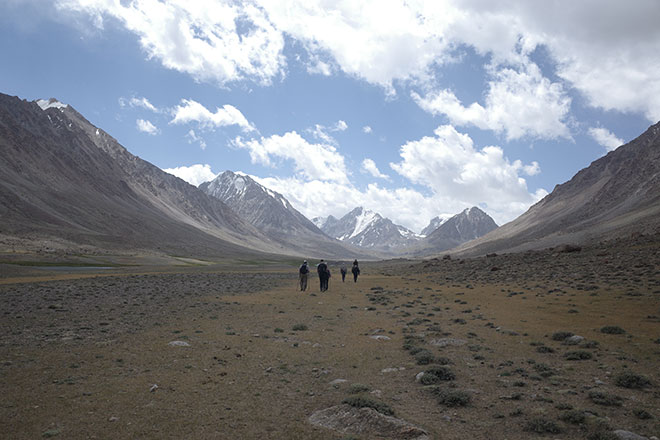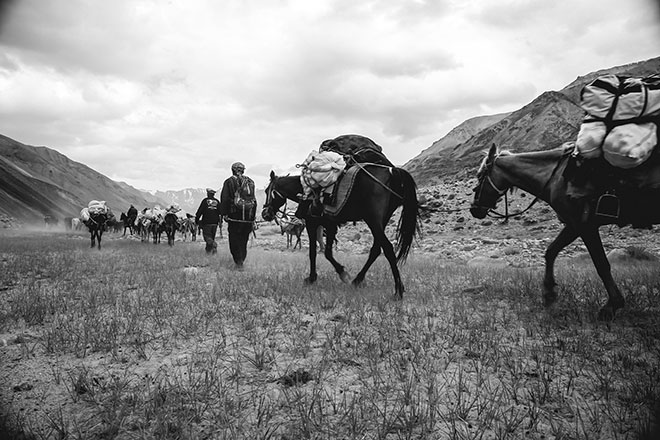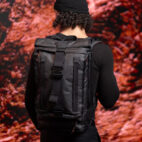What to Carry on Expedition in Afghanistan’s Pamir Mountains
An expedition quartermaster shares the luggage requirements for an expedition to and through a remote mountain range in Afghanistan.
In July this year I’m heading to Afghanistan’s Pamirs mountain range for three weeks to map trekking and bikepacking routes. As this year’s principal quartermaster, I’m responsible for ensuring the teams have the best equipment and supplies to carry them through this difficult assignment.
In this article I’ll share some of the thinking behind our luggage requirements, drawing on last year’s Afghanistan expedition to the same region.

The Mission
Last summer a team of ten ventured into the Big Pamir, a remote mountain range in Afghanistan that sits between Tajikistan, Pakistan and China. Our team included a leader, medic, quartermaster, hydrationist, communications, cartographer (myself) plus local trekking guide and cook. Our entourage was joined by yaks, horses and donkeys serving as pack animals, along with their herders.
The expedition lasted three weeks. It takes a full six days to travel to the trail head, followed by twelve days of trekking, and another three days to reach our end point, the town of Khorog. In July the temperatures went to +20ºC during the day, at high altitude it would reach -5ºC at night with occasional snow storms.
The team convened in Dushanbe, Tajikistan, to sync up for initial route planning and to stock up on provisions that were not packed into the country. From Dushanbe we traveled southeast through Tajikistan to Khorog, and onward across the Afghan border at Ishkashim. Once in Afghanistan, we made our way east via 4WD to the foothills of the Pamirs, and up into the mountains on foot for a twelve-day trek. To give a sense of the quality of the roads—in Tajikistan we averaged 60-100kph, whilst in Afghanistan it was a mere 13kph, including river crossings—mostly driving Toyota Land Cruisers. The roads are rough!

Our goal, to map trekking routes, is part of a broader initiative to support sustainable socio-economic development, through adventure tourism. While you might imagine fitness is the main issue to trek at altitude, the team had to deal with prolonged time at altitude (impact on diet), multi-day trekking (fatigue), limited access to infrastructure, exposure to poverty, sickness, diet, the elements and being in Afghanistan—whilst this is a peaceful part of the country it takes effort to challenge a lifetime of preconceptions. In other words it’s as much mental as physical. Essentially—we entered as a group and emerged as a team.
In keeping with Studio D’s operational philosophy, we like to maintain a light footprint—no heavy wheeled luggage, minimal equipment, aside from mission critical items such as water purification systems that required redundancy.

What We Look For
At a high level the equipment needs to be versatile, rugged and discreet:
Versatility of the luggage is extremely important, as the range of scenarios through which it must be carried is quite broad, and can be unpredictably varied. A piece of kit may be crammed into a 4WD or stashed on top of it for one leg of the journey, carried on one’s back, strapped to a pack animal (yak or horse) for all-day carriage or temporary river crossings, or hauled piece by piece manually through a border checkpoint where vehicles cannot transit.
Closely related and equally desirable is ruggedness: the gear needs to be able to survive being tied to a pack animal for up to 12 hours a day (often dealing with significant abrasions), dragged through the mud, rainstorms, snow, and constant grit and grime.
Discretion of the luggage is preferred—while it is difficult to completely obscure one’s origin while traveling through Central Asia and into Afghanistan, there is no particular need to scream out “obvious tourist!” or “potential military!” with flashy or overtly technical gear. And of course, one needs to bring a wide range of luggage for the variety of kit being hauled: camp gear, kitchen, medkits, daypacks with immediate necessities to hand, etc.


What We Did
Gear planning started in earnest four months before we arrived, with shared and personal gear lists circulated amongst the team. In addition, different members collated equipment according to their role, for example the two medics built a comprehensive list of meds, plus laminated standard operating procedure cards, for different scenarios.

After reviewing and picking up supplies in Dushanbe regarding the plan for the drive and trek ahead, we loaded in extra provisions from the one and only supermarket we were to see the entire trip, then made our way roughly along the Tajikistan-Afghanistan border to Khorog, the last reasonably-sized town we were to see until returning about two weeks later. Khorog provided an opportunity to stock up on additional provisions available in the marketplace (trail mix ingredients, root vegetables, a few last-minute gifts for locals across the border), and left us within a day’s drive of the crossing point. From Khorog, we traveled to Sultan Ishkashim, practically a stone’s throw from the border crossing, at something akin to the Last Homely House run by a Tajik local. The next morning, lugging our gear through the border checkpoint by hand, we were in Afghanistan.
Once in Afghanistan, we synced up with our local guide and interpreter, obtained additional paperwork, and proceeded to plan the specifics of the route. An alternate start point needed to be found due to a landslide and washed out “road”. When the road would be repaired—nobody could say, it could take half a year.

Heading to the trailhead, we drove over the roughest “roads” I’ve ever encountered. From here we had twelve days of trekking across arid landscapes and high alpine pastures, before resyncing with our drivers for the drive back. At our furthest point we were six days from the nearest dirt road, and up to ten days from the nearest serviceable clinic. It turns out getting into the country is the easy part, getting out takes a bit more effort—with some minor administrative quibbles that needed resolving at the border.

The Range of Situations That Luggage Would Be Used
Pack animals: Often lashed roughly to horses, donkeys, or yaks, particularly larger bags. More fragile containers such as water bags and water canisters without tight seals did not survive this. Strong materials were preferable here; our Dyneema kit fared well.
Border crossing: The crossing point between Tajikistan and Afghanistan was not open to general vehicle traffic, so all gear had to be hauled by hand across the border. The largest bags (90L custom/experimental kit) fortunately had backpack-capable straps to help with the heavy loads. Remember to distribute your weight evenly.
4WD: Loaded in back or optionally on top. Occasional breakdowns / field repairs needed, including one point which necessitated swapping to a different vehicle entirely and shifting all the gear. Only got stuck in a river once, but that may have been luck.
Trekking: Larger bags on pack animals, daypacks on backs. Thanks to animal carriage of heavier gear, daypacks could be optimized for easy access to essentials, mainly water (average 5L consumed per person per day, usually with an option to refill around lunch), rain gear, cold-weather accessories, and first aid.
Weather changes: Rain could sweep in quickly; heat could be oppressive in the earlier days at relatively lower altitudes; cold could be unexpectedly intense up high. Multiple days had snow / sleet, including during one of the high passes.
Camp set up/set down: Most camp kit (tents / sleeping gear, kitchen, food) was stored in large duffels; these often went ahead of the main trekking group on foot as the pack animals were typically faster.
Storage in Khorog: Guest house-provided storage locker was used to stash a duffel of spare gear, electronics of no use in the mountains, and one mountain bike.

What We Carried
Duffels: Four 80L Arc’teryx Carrier duffels for shared equipment (tents, rollmats, cooking gear, food supplies); two SDR Traveller 60L and 80L duffel prototypes; a wide variety of personal duffels from individuals’ favorite brands—including The North Face and Patagonia.
Daypacks: Entirely personal preference. The expedition lead carried a custom experimental SDR Traveller Dyneema pack; I used a UL Gossamer Gear Murmur pack, and there were a couple Ospreys plus a variety of other brands in the group.
Pouches: Primarily SDR Traveller 1M Hauly’s, which at 20L and with haul loops were ideal to be strapped to pack animals or stowed in larger duffels, and were used for everything from carrying lunch supplies and kitchen gear, to gas canisters and electronics. Extremely versatile and useful. A number of Sea To Summit roll-tops.

Specialised gear:
A Särmä TST map case housed the master copy of the planned expedition route and the prior year’s route taken. This was updated daily with campsite locations and route info where it deviated from the prior trip. Excellent for scribbling on the clear cover with a Sharpie.
Durable SDR Traveller trash carry-out rolltops.
Grain sacks, for equipment and supplies bought in Afghanistan
The other main equipment stowed in the group duffels were:
The team equipment included three The North Face VE 25’s and one Assault 3. Personal shelters brought by team members: one Outdoor Research bivy for a bit of extra coverage while sleeping under the stars, and I brought along a Hyperlite Echo 2 system for a bit of personal space. The expedition leader slept under the stars most nights (and crawled into the Assault 3 when it snowed).
Exped DownMat XP 9 LW with Sea To Summit Aeros Ultralight Pillows.
For water purification we had two redundant systems: the Katadyn Base Camp Pro 10L Water Filter and Potable Aqua Iodine tablets. A cleaned filter can parse 10L of water in 30 minutes, but once clogged, the same volume can take 5 hours. On some days it was easier to just use iodine.
For cooking we carried two redundant systems: a Jetboil Genesis Base Camp and an Iranian pressure cooker bought in the market in Sultan Ishkashim.

Issues Faced
Weather: Weather reports via satellite communications were mostly inaccurate due to the highly localised nature of the weather events—it could be snowing in one valley and clear sunshine a few hundred meters over in another. At lower elevations the days were hot and the nights cool; at higher elevations the days were cool and the nights occasionally below freezing. We awoke to unexpected snow at a couple of camps, and were caught in one major rainstorm that arrived just as we got to our campsite at the end of a ~20 mile day. Quick access to rain gear and cold-weather accessories in daypacks was a must, as well as tarps to rig an emergency shelter as we also had to do on one cold descent through a mix of rain and snow when one of our team risked hypothermia.
Access: Once a few hours outside of Dushanbe, access to everything became more difficult—the roads that seemed rough getting to Khorog and the border crossing were quickly overshadowed by the bouldery tracks on the Afghan side that could make a journey of a few miles take the better part of a day (we averaged 13kph on Afghan roads with our Toyota Land Cruisers). Once in the mountains, access to the nearest outpost of civilization was days away; this was a focal point for our medics—in the event of an emergency, timely access to medical services could literally make the difference between life and death. Multiple layers of contingency plans were in place for different points along the route, taking into account inhabited areas on both sides of the Afghan-Tajik border.
Fatigue: After three or four days of trekking at altitude, fatigue became an issue for all members of the team. While all participants were physically fit and had been pre-vetted before joining the expedition, days in the 15-20 mile range and multiple days in a row above 14,000 feet with a necessarily limited diet can take a toll. Almost all participants used trekking poles daily to help ease the strain, and to stay safe on river crossings when made by foot rather than horse or yak.
Theft: We were wary of petty theft at checkpoints and other crossings but as it happens it was a non-issue. Perhaps fundamentally because the communities we travelled through were honest and respectful of their guests, and in a few places, because we minimised opportunities.

Border crossings: The crossing between Tajikistan and Afghanistan is known to be unstable, and with limited infrastructure, you are essentially at the mercy of the official manning the crossing point. Some kind of hustle is common in this part of the world and “expediting fees” can be a challenge. Getting in is one thing, getting out quite another! Pro tip: check that the stamped paperwork on the way in is properly stamped, otherwise there’ll be fees on the way out.
Dust: Everywhere. Particularly on the road where there is very little chance of getting A/C, the windows will be down and this will wind up caking you. Wraparound spectacles and a makeshift face mask (scarves can be purchased at the border market) are a must.
Snow: While we planned for snow around the high passes (including one with an adjoining glacier which must be crossed immediately after making the pass), we did experience two light snowstorms that threatened to become heavier. This became an issue towards the end of the route in particular, when trekkers were generally more fatigued and lean; hypothermia was a very real risk, and necessitated quick access to extra layers, makeshift shelter, and the ability to quickly whip up something hot to drink. In the morning we filled a Yeti Rambler one-gallon jug with hot water for just this occasion.
Pack/unpack: While the team improved as the route progressed, breaking camp in the mornings initially took longer than planned for, which could impact the entire rest of the day. Each morning, everything not carried personally had to be carefully packed and loaded onto the pack animals that could take up to an hour—or more if there was an argument between our local guide and the settlements renting the yaks and horses. The occasional yurt stay sped up the building/breaking camp, but the rest of the gear (personal sleeping arrangements, kitchen, clothing, etc.) all had to be cleaned up and arranged each morning regardless.

Planning 2020
The new challenge this year is that we’re working at a greater scale—running up to five expeditions back to back, and have more remote and diverse routes, including one for bikepacking, necessitating a different mix of redundancy and diversity in the kit. Having one cycle route also presents challenging re-supply issues in the remotest corners of the mountain range, and we anticipate the need for remote supply dumps.
Routes this year will be run in a staggered fashion, and kits will be reused by different routes, so they must be specced for the maximum team size which will use them, and consumables must be able to be replenished in between uses. Repair and critical item redundancy e.g. water purification systems and med kits are consequently much more pertinent this time around, as the kit will be supporting a greater number of people and seeing more overall use, hence the high value placed on ruggedness and durability of the luggage and equipment in general. This time around we also have a remote ops person serving as a mission control—allowing us centralized coordination of the different routes in the event of an emergency.
We’re open to taking new equipment this year, if anyone has rugged, versatile luggage in need of a workout and a review—please contact the author.
To hear about upcoming expeditions to Afghanistan and elsewhere subscribe to the Radar mailing list.

About the author: Alex is the Principal Quartermaster on the 2020 Mapping the Afghan Pamirs Expeditions to Afghanistan, and in 2019 served as Cartographer role.
All photos: Alex, unless otherwise stated.





 Carry Awards
Carry Awards Insights
Insights Liking
Liking Projects
Projects Interviews
Interviews











